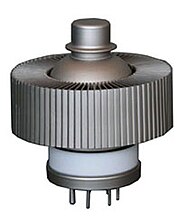Triode

A triode is an electronic
The name "triode" was coined by British physicist William Eccles[2][3] some time around 1920, derived from the Greek τρίοδος, tríodos, from tri- (three) and hodós (road, way), originally meaning the place where three roads meet.
History
Precursor devices


Before thermionic valves were invented, Philipp Lenard used the principle of grid control while conducting photoelectric experiments in 1902.[4]
The first
Invention
Triodes came about in 1906 when American engineer
De Forest's Audion did not see much use until its ability to amplify was recognized around 1912 by several researchers,
Wider adoption
The discovery of the triode's amplifying ability in 1912 revolutionized electrical technology, creating the new field of
The triode served as the technological base from which later vacuum tubes developed, such as the
The triode was very widely used in
Construction

All triodes have a hot
Low power triodes
Low power triodes have a concentric construction (see drawing right), with the grid and anode as circular or oval cylinders surrounding the cathode. The
High-power triodes
High-power triodes generally use a
Lighthouse tubes
This section needs additional citations for verification. (April 2022) |

A type of low power triode for use at
As well, high-frequency performance is limited by transit time: the time required for electrons to travel from cathode to anode. Transit time effects are complicated, but one simple effect is input conductance, also known as grid loading. At extreme high frequencies, electrons arriving at the grid may become out of phase with those departing towards the anode. This imbalance of charge causes the grid to exhibit a reactance that is much less than its low-frequency "open circuit" characteristic.
Transit time effects are reduced by reduced spacings in the tube. Tubes such as the 416B (a Lighthouse design) and the 7768 (an all-ceramic miniaturised design) are specified for operation to 4 GHz. They feature greatly reduced grid-cathode spacings of the order of 0.1 mm.
These greatly reduced grid spacings also give a much higher amplification factor than conventional axial designs. The 7768 has an amplification factor of 225, compared with 100 for the 6AV6 used in domestic radios and about the maximum possible for an axial design.
Anode-grid capacitance is not especially low in these designs. The 6AV6 anode-grid capacitance is 2 picofarads (pF), the 7768 has a value of 1.7 pF. The close electrode spacing used in microwave tubes increases capacitances, but this increase is offset by their overall reduced dimensions compared to lower-frequency tubes.
Operation
In the triode,
The magnitude of this current can be controlled by a voltage applied on the grid (relative to the cathode). The grid acts like a gate for the electrons. A more negative voltage on the grid will repel more of the electrons, so fewer get through to the anode, reducing the anode current. A less negative voltage on the grid will allow more electrons from the cathode to reach the anode, increasing the anode current. Therefore, an input AC signal on the grid of a few volts (or less), even at a very high impedance (since essentially no current flows through the grid) can control a much more powerful anode current, resulting in
The triode is a normally "on" device; and current flows to the anode with zero voltage on the grid. The anode current is progressively reduced as the grid is made more negative relative to the cathode. Usually a constant DC voltage ("bias") is applied to the grid along with the varying signal voltage superimposed on it. That bias is required so that the positive peaks of the signal never drive the grid positive with respect to the cathode which would result in grid current and non-linear behaviour. A sufficiently negative voltage on the grid (usually around 3-5 volts in small tubes such as the 6AV6, but as much as –130 volts in early audio power devices such as the '45), will prevent any electrons from getting through to the anode, turning off the anode current. This is called the "cutoff voltage". Since beyond cutoff the anode current ceases to respond to the grid voltage, the voltage on the grid must remain above the cutoff voltage for faithful (linear) amplification as well as not exceeding the cathode voltage.
The triode is somewhat similar in operation to the n-channel
Applications
This section needs additional citations for verification. (March 2012) |
Although S.G. Brown's Type G Telephone Relay (using a magnetic "earphone" mechanism driving a carbon microphone element) was able to give power amplification and had been in use as early as 1914, it was a purely mechanical device with limited frequency range and fidelity. It was suited only to a limited range of audio frequencies - essentially voice frequencies.[23]
The triode was the first non-mechanical device to provide power gain at audio and radio frequencies, and made
Vacuum tubes are obsolete in mass-marketed
Characteristics

In triode datasheets, characteristics linking the anode current (Ia) to anode voltage (Va) and grid voltage (Vg) are usually given. From here, a circuit designer can choose the operating point of the particular triode. Then the output voltage and amplification of the triode can be evaluated graphically by drawing a load line on the graph.
In the example characteristic shown on the image, suppose we wish to operate it at a quiescent anode voltage Va of 200 V and a grid
Now suppose we impress on the −1 V bias voltage a signal of 1 V peak-peak, so that the grid voltage varies between −0.5 V and −1.5 V. When Vg = −0.5 V, the anode current will increase to 3.1 mA, lowering the anode voltage to Va = V+ − 10 kΩ × 3.1 mA = 191 V (orange curve). When Vg = −1.5 V, the anode current will decrease to 1.4 mA, raising the anode voltage to Va = V+ − 10 kΩ × 1.4 mA = 208 V (green curve). Therefore a 1 V peak-peak signal on the input (grid) causes an output voltage change of about 17 V.
Thus voltage amplification of the signal is obtained. The ratio of these two changes, the voltage amplification factor (or mu) is 17 in this case. It is also possible to use triodes as cathode followers in which there is no voltage amplification but a huge reduction in dynamic impedance; in other words, the current is greatly amplified (as it also is in the common-cathode configuration described above). Amplifying either the voltage or current results in power amplification, the general purpose of an amplifying tube (after all, either the current or voltage alone could be increased by decreasing the other just using a transformer, a passive device).
See also
References
- ^ ISBN 978-0470409749.
- ISBN 110762956X.
- ISBN 978-9814434812.
- ISBN 0863413277.
- ISBN 978-1400854608.
- ISBN 1887178171.
- ^ a b c Tyne, Gerald F. J. (September 1943). "The Saga of the Vacuum Tube, Part 6" (PDF). Radio News. 30 (3). Chicago, IL: Ziff-Davis: 26–28, 91. Retrieved November 30, 2016.
- ^ a b Tyne, Gerald F. J. (November 1943). "The Saga of the Vacuum Tube, Part 8" (PDF). Radio News. 30 (5). Chicago, IL: Ziff-Davis: 26–28. Retrieved November 30, 2016.
- ^ a b Anton A. Huurdeman, The Worldwide History of Telecommunications, John Wiley & Sons - 2003, page 226
- ^ John Bray, The Communications Miracle: The Telecommunication Pioneers from Morse to the Information Superhighway, Springe - 2013, pages 64-65
- ^ [1] DRP 179807
- ISBN 0-471-71814-9, p.335
- ISBN 90-5199-145-2page 20
- . Retrieved March 30, 2021. The link is to a reprint of the paper in the Scientific American Supplement, Nos. 1665 and 1666, November 30, 1907 and December 7, 1907, p.348-350 and 354-356
- ^ U.S. patent 879,532, Space Telegraphy, filed January 29, 1907, issued February 18, 1908
- ISBN 0934223238.
- ^ ISBN 9051991452.
- ^ ISBN 0521835267.
- ^ John Bray, The Communications Miracle: The Telecommunication Pioneers from Morse to the Information Superhighway, Springe - 2013, page 64
- ISBN 1579584640.
- .
- ISBN 0934223238, pages 93-94
- ^ Tyne, Gerald F.J., Saga of the Vacuum Tube, 1977, Howard W. Sams, pp 201~202
- ^ "Tubes Versus Solid-State Audio Amps—The Last Word (Or "House Of Fire," Part 2)". www.electronicdesign.com. Retrieved 2022-04-20.
External links
- Les lampes radio — A French page on thermionic valves. Of particular interest is the 17-minute video showing the manual production of triodes.
- Triode valve tutorial




